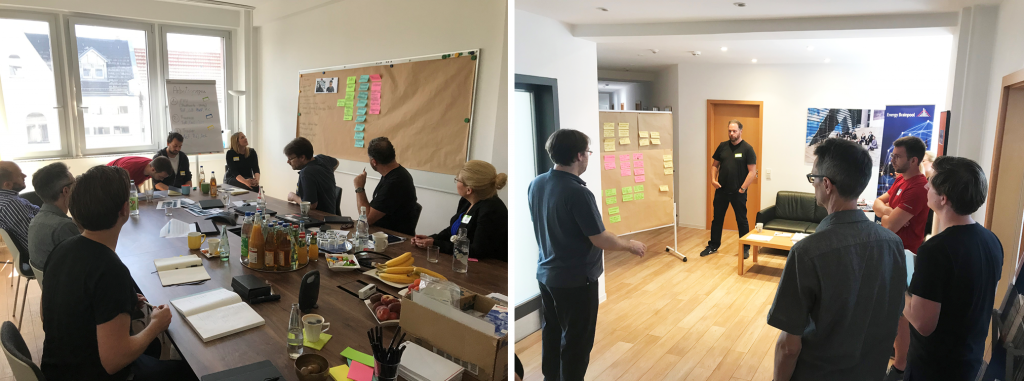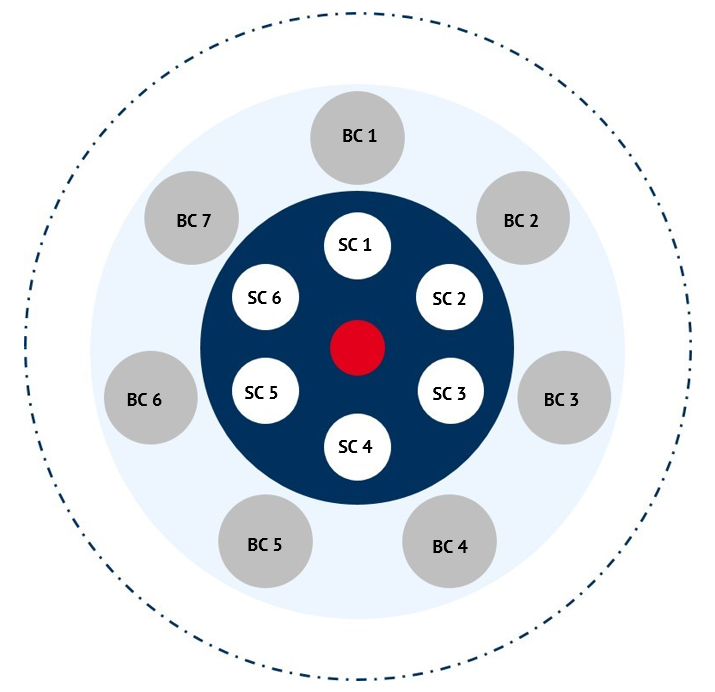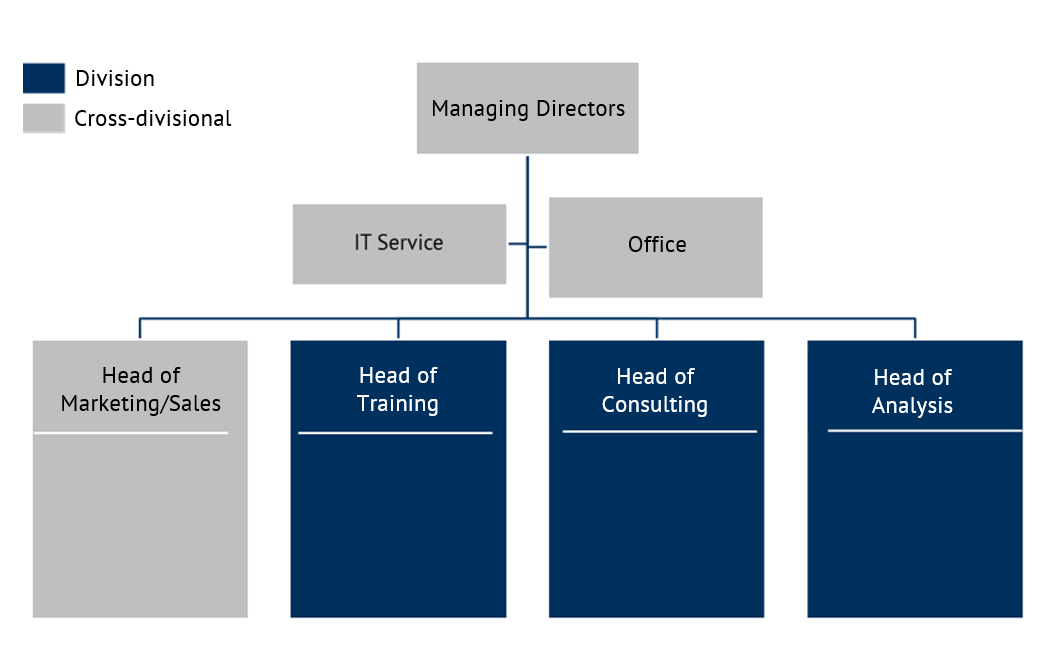According to the current Public Utility Study 2019 of the bdew, an agile and innovation-promoting corporate culture is virtually essential for survival in the energy market. But what does this mean?
In the first Part of our Series “Agile, SCRUM, New Work” we looked at the basic attitude and the image of people in an agile environment. Under the question “Agile: Is it useful or can we do without it?”, we analysed under which circumstances agile working methods are meaningful and when not. Because we do not believe in universal recipes.
We are convinced that every company can and must find the right balance between structure and flexibility and an individual mix of hierarchical and self-organised forms of organisation. In this second part, based on our own experiences in the transformation of Energy Brainpool, we will now look in detail at what makes a modern, dynamic organisation and what is crucial on the way there.
When we talk about organisation in the following analysis, we mean all possible levels of organisation: from the company, to divisions and departments, to teams.
Aligning employee, market and customer needs
It is crucial to find out what degree of agility and self-organisation is appropriate for your company and its units. Where we recognise the need to work agile in complex situations, there is no alternative to fundamentally questioning the organisation and cooperation and designing it appropriately.
At the same time, the people affected by this change must not only be carried along with it, but also actively participate in shaping it in order to get on the road to success.
“In principle, the more members of the organisation you involve in the design process, the better the result.“ (Niels Pfläging, Organisation for Complexity)

At Energy Brainpool, we involved all team members in the parts of the process that affected everyone in our company. Other parts, which only affected certain areas, were only developed in these areas. Then we presented them to the whole team to make sure that everyone understood the parts in depth. The aim is to improve the cooperation between the individual parts.
The goal of agile, living organisations is to adapt more quickly to market and customer needs. This is not a linear process. Agile working methods are always iteratively in close exchange with the respective stakeholders. Such customer-oriented processes lead to a completely different experience of cooperation. To achieve this, an agile organisation must also enable teams to work more independently and without a classic hierarchy.
Agility allows the focus to shift from the top of the company to the customer. In the process, classic organisational structures often give way to process organisations that place the customer in the foreground. This requires a new understanding of roles and responsibilities must be distributed differently and usually decentralised. This also requires a culture that recognises that mistakes are unavoidable on this path. Mistakes should be openly communicated so that everyone has the opportunity to learn from the experiences made and to become better.
What can such a dynamic living organisation look like?
What all models have in common is that they place great value on decentralisation, autonomy and self-organisation. This makes it possible to act quickly and thus guarantee innovation and customer proximity. Examples of further literature on this subject are Reinventing Organisations by Frederic Laloux and Holacrazy by Brian J. Robertson.
To achieve this, hierarchy must become a network. Instead of a top there is then a middle. It is the heart of the organisation and empowers those involved to make the right decisions rather than giving them instructions.
Informal structures versus official value added structures
Often, however, the insistence on official structures prevents more successful, efficient work within the dynamic network. Because problem solving in complex situations often requires fast and uncomplicated communication and cooperation across departmental boundaries.
Energy companies that are subject to regulation due to unbundling naturally reach the limits of what is feasible here.
Disadvantages of classical-hierarchical structures
In general, classic hierarchical structures, in which communication between sub-areas often runs through the respective managers, are often too slow and important information is lost along the way.
Therefore, even today this is often done unofficially “through the unofficially official channels”, based on personal relationships. Recognising this and making use of this dynamic is a characteristic of a living organisation.
The organisation is successful when it removes barriers so that different people work for and with each other towards a common goal. The organisational units are integrated as functionally as possible. This means that the business processes take place largely within the unit so that it can really react quickly and autonomously to market needs.
Circular organisation replaces classic structures
This often leads to the dissolution of classic structures and departments. Instead of the departments Procurement, Sales and Accounting, the various functions are found in all units.
The whole is often compared to a system of living cells. We call the units circles.

Fig. 3: New organisation chart Energy Brainpool (Business Circles (BC) are the areas where the actual business activity, value creation and interaction with the market takes place. SC: Service Circles support BC in its activities, this includes the Management).
We have formulated four principles for these:
- Communication does not take place through higher-level managers, but “across” circles, typically in connection with market mechanisms.
- Communication between circles takes place at eye level.
- All business processes are largely within one circle.
- Self-control within the circle is as complete as possible.
This means that within the circles, almost all decisions are made independently and goals are formulated by themselves. But how is it ensured that a common goal is also worked towards across circles? The success factors are common to all network organisations:
Shared visions and values
Committed to a common vision that has to be achieved and the definition of common values, suitable sub-goals and a framework of rules can be worked out, within which work can be done flexibly and self-determined.
The philosopher Axel Honneth, Director of the Institute for Social Research in Frankfurt until 2018, wrote as early as 1994 that societies need “a social appreciation of the kind that can only be achieved on the basis of shared objectives”. Accordingly, they are held together by what is to be achieved together. This certainly applies equally to economic organisations.
At Energy Brainpool, we have taken a lot of time and effort to develop the common vision and values at the beginning of our transformation process. This was questioned, but it has proved its worth. Having really worked out this common denominator so clearly in dialogue is the solid foundation of our organisation today. Who wants to build on sand?
High transparency is important
In order for people within the organisation to be able to make the right decisions, access to all necessary information is required. The greatest possible transparency and tools that ensure that this information is available in the most up-to-date form are irreplaceable in this regard. This also facilitates a clear focus on results.
On the one hand, we have ensured that all key figures are available to all employees at least once a week and have expanded digital access rights. Secondly, we have further developed our meeting culture to make it both more effective and more efficient. They have also become more fun.
Clear understanding of roles and responsibilities
A decentralised, autonomous and living organisation does not mean the dissolution of all processes and rules. They are only redefined. Here it is particularly important that everyone has a clear common understanding of what roles there are, what tasks they have to perform and who bears what responsibility.
This does not necessarily have to lead to the abolition of any hierarchy. In this context, however, it tends to be based on knowledge and excellence and is not defined by positions.
At Energy Brainpool, we have distributed responsibility on more shoulders and at the same time defined roles and processes more clearly. However, classic, hierarchical positions have almost completely disappeared. This makes it possible for each person to take on different roles in different places. We have thus become more flexible and dynamic, and there is still more clarity. We are still in a permanent process of adjustment and improvement.
Excellent communication
In an organisation that lives from self-responsibility and is designed to interact with a constantly changing environment, the communication behavior of people among each other is the most important key to success.
The exchange must be characterised by fair and appreciative interaction with each other, if possible on an equal footing and create an environment in which mistakes are dealt with openly. It must also be ensured that this does not only take place within the unit, but also between different units.
We are guided by the maxim: as much communication as necessary, but as little as possible. This, however, requires a certain willingness to learn in order to develop a better awareness of one’s own behaviour and that of others, to give open and fair feedback and thus jointly increase effectiveness.
Value creation is a collective process
In summary, it can be said that the value creation structure of a living organisation is based on people and their interactions.
Value creation is never the sum of individual achievements, but a collective process. This is all the more convincing because research results prove: individual performance is a myth, in organisations it simply does not exist.
“We have learned that the professional expertise of individuals is not a characteristic feature of top performance. High performance is characterized by diversified social networks.“ (Cross, Rob et. Al: The Hidden power of Social Networks, Boston: Harvard Business School Press 2004).
This dynamic form of collaboration literally screams for different methods and tools than we are used to. We will take a closer look at the most common ones in the next Part of our Series “Toolbox of agile methods: SCRUM, Design Thinking and Co.“.
New: In line with this, we are holding our new Live-Online-Workshop “Agility in the Energy Market” on December 8. & 10, 2020.
Here is Part 3 of our Series: “Toolbox of agile methods: SCRUM, Design Thinking and Co.“





